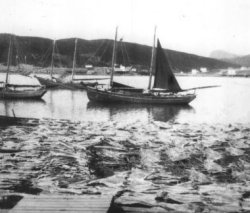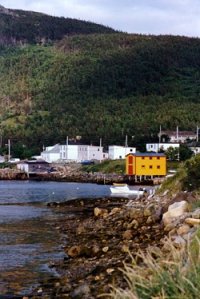Fox Harbour
 Fox Harbour, like other communities in close proximity to Placentia, may have been used by the
French in the 1600's. With its level land and easy access to the fishing grounds, Fox Harbour
provided an alternative to settlement in the older over overcrowded communities in the immediate
Placentia area. Such settlements may be due to the fact that early inhabitants trying to escape
detection be French and English troops, may have seen Fox Harbour with its rock strewn entrance
as the ideal place to hide.
Fox Harbour, like other communities in close proximity to Placentia, may have been used by the
French in the 1600's. With its level land and easy access to the fishing grounds, Fox Harbour
provided an alternative to settlement in the older over overcrowded communities in the immediate
Placentia area. Such settlements may be due to the fact that early inhabitants trying to escape
detection be French and English troops, may have seen Fox Harbour with its rock strewn entrance
as the ideal place to hide.
It is not certain how Fox Harbour got its name. E.R Seary, 1971 says that the community is most likely
named for an animal rather that a family name."Home of Wooden Boats and Iron Men" claims
that the name Fox Harbour is relatively new, that the community was at one time, known as,
" Little Glocester... because of Yankee traders from Glocester, New England". Another
possibility, perhaps showing the French influence is that , because of the difficulty in
entering the harbour, Fox Harbor was often referred to as a "faux", or false harbour.
Whatever the origin of the place name, the name Fox Harbour has appeared in the census
since 1834.
Despite the lack of documented evidence, it has long been held that the first inhabitants of
Fox Harbour were George, Martin, and Matthew Spurrier, (Spurvey or Sporier) settled here in
the late 1700's or early 1800's. They were joined in 1806 by three families probably of
Irish origin, named Dreaddy, Healey, and Kelly. It is believed that between
1836 and 1857 (when the population of Fox Harbour jumped from 42 to 147), an influence
of primarily Irish immigrants brought the Duke, Foley, King, O'Leary, McCue, Murray, Davis,
Sampson, and Whiffen families to Fox Harbour. Family tradition cites Michael O'Reilly
(1790 - 1879) as migrating from Ireland to Newfoundland in 1815 and settled at
Fox Harbour. Hutchinson's Newfoundland Directory for 1864 lists the principal
inhabitants of Fox Harbour as Catherine Bird teacher; James Davis, Planter and dealer;
and James Spurvery; Planter. Both the Foley and Sampson families reputedly came from
Little Placentia (Argentia). Later family names associated with the settlement in the
Nineteenth Century are Lynch, Darmedy, O'Reilly, Mullins, Nolan, Steveson and Lane; and in
the early 1900's, Murphy, Ennis, Howe, Pittman, Bruce, and Harnett are mainly of Irish
origin. Though some are English and are strongly associated with the Placentia area. Although
the Census reported a predominantly Newfoundland born population throughout the 1800's it is
probable that Fox Harbour was settled by second-generation planter-immigrants whose fathers
had come to Newfoundland as fisherman and planters attached to the merchant firms of Placentia
and Little Placentia.
Fox Harbour owes its very existence to the fishery. It was fish that brought the early settlers.
With the fishing grounds nearly, many of these early settlers, made their living from the sea.
According to census records dating from 1845 - 1921, Fox Harbor , in 1845 had a population of
39 people with 3 fishing boats. Twelve years later in 1857 , there was population of one
hundred and forty-seven people with 14 boats, and 40 nets and seines . By 1921 the population had reached four hundred and Seventy-one, with sixteen large vessels of 20 - 60 tons, and 58 smaller boats with a capacity up to 30 quintals of fish.
This trend continued until the 1930's and early 1940's, just before the American base started
at Argentia. Because of the poor economy, many fishermen left Fox Harbour at this time and went
to Boston, New York and New Bedford to pursue the fishery there. Indeed, by the time the base started
in 1942, many Fox Harbour fishermen had already given up fishing.
Occupations such as lumbering , railway and road construction provided alternate employment
to those not actively engaged in the fishery. With the construction of the Argentia Base many
people exchanged their skills as fishermen for skills as tradesmen and technicians to work on
the Base in construction work, services, maintenance and administration.
 With the phase-down of the Argentia Base in 1969 the population
of Fox Harbour declined to 685 by 1971 and 627 by 1976.
With the phase-down of the Argentia Base in 1969 the population
of Fox Harbour declined to 685 by 1971 and 627 by 1976.
Today, Fox Harbour like so many rural towns in Newfoundland is but a shadow of its former self.
Many factors have contributed to its decline, perhaps the most important being the poor
economic climate of recent years. With the close-down of the American base, the close-out of
ERCO, the moratoruim on the fishery, all of the communities in this area, including Fox Harbour,
have been drastically affected.
The trend begun in the thirties, of the young people leaving
the province,took on a new life. Most of the young people have gone farther afield to find jobs
and make a better future for themselves. The population which peaked in 1966, at 765 has shrunk
to the present population of 430. This decrease in population has had a severe social impact
whose effect was felt most severely in the field of education. With a shrinking enrolment,
the school was fazed down over a number of years and in December 1993, St. Regis closed its
doors for the last time.
 Other family names not mentioned above that are currently residing in
Fox Harbour are: Culleton, Griffiths, Smith, Gambin, Quilty,
Wells, Ducey, Hynes, Carroll, Clower, Mulrooney, Maher, Ryan,
Pendergast, Francis, Kerrivan, Piercy, King, Brown, George,
Buckmaster, Parsons, Traverse, Barron, Perham, Donahue, O'Brien,
Fulford, Flynn, and Collins.
Other family names not mentioned above that are currently residing in
Fox Harbour are: Culleton, Griffiths, Smith, Gambin, Quilty,
Wells, Ducey, Hynes, Carroll, Clower, Mulrooney, Maher, Ryan,
Pendergast, Francis, Kerrivan, Piercy, King, Brown, George,
Buckmaster, Parsons, Traverse, Barron, Perham, Donahue, O'Brien,
Fulford, Flynn, and Collins.

Sources:
Barron, Elizabeth & King, Mary, "Fox Harbour Memories"
 Fox Harbour, like other communities in close proximity to Placentia, may have been used by the
French in the 1600's. With its level land and easy access to the fishing grounds, Fox Harbour
provided an alternative to settlement in the older over overcrowded communities in the immediate
Placentia area. Such settlements may be due to the fact that early inhabitants trying to escape
detection be French and English troops, may have seen Fox Harbour with its rock strewn entrance
as the ideal place to hide.
Fox Harbour, like other communities in close proximity to Placentia, may have been used by the
French in the 1600's. With its level land and easy access to the fishing grounds, Fox Harbour
provided an alternative to settlement in the older over overcrowded communities in the immediate
Placentia area. Such settlements may be due to the fact that early inhabitants trying to escape
detection be French and English troops, may have seen Fox Harbour with its rock strewn entrance
as the ideal place to hide.  With the phase-down of the Argentia Base in 1969 the population
of Fox Harbour declined to 685 by 1971 and 627 by 1976.
With the phase-down of the Argentia Base in 1969 the population
of Fox Harbour declined to 685 by 1971 and 627 by 1976. 